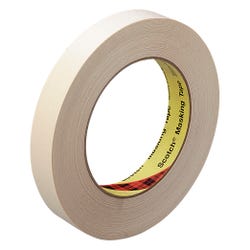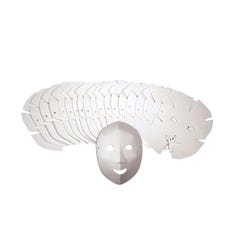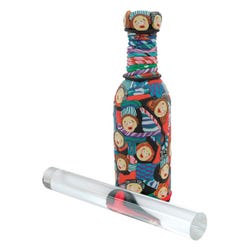Light As Air Masquerade

Description
Masks serve many cultural and historical purposes. Faces are the first thing we look at when we meet people, and thus form an important first impression, as well as lasting remembrance. Masks easily spark students' imaginations. Amaco® Cloud Clay® will be used as the expressive media to stretch over Roylco® tag board pre-cut mask templates.
Objectives
- Students will study face composition and design a mask that is both expressive and colorful.
- Students may use the mask for its own art object sake, or in a play, myth or folktale.
Supplies Needed
Roylco® Folding Fun Masks, Set of 40 407118
Amaco® Cloud Clay® Assorted Color Classroom Pack, 6 lbs. 1361983
Amaco® Designer Push Mold, Day of the Dead Theme 1402966
Amaco® Designer Push Mold, Leaf Theme 1402964
Amaco® Designer Push Mold, Fossils Theme 1402973
Amaco® PolyRoller&trade 407688
Amaco® Craft Clay Machine 405680
Amaco® Rub 'n Buff® Gold Metallic Finish, .5 oz. 1334824
Scotch® 232 Masking Tape, 1" x 60 yds. 005295
Elastic cord, 1/16 085780
Sax® True Flow® Gloss Tempera Varnish, Quart 402269
Other Materials
Assorted Permanent Markers
Standards
CONTENT Standard #1: Understanding and applying media, techniques and processes.
CONTENT Standard #2: Using knowledge of structures and functions.
CONTENT Standard #4: Understanding the visual arts in relation to history and culture.
CONTENT Standard #6: Making connections between the visual arts and other disciplines.
Instructions
1
Motivate the students by looking at masks of various cultures. Discuss their possible uses as well as common characteristics. Great masks are dramatic, expressive and exaggerated.
2
Students might learn about facial structure in a pre-mask activity by drawing self portraits using a mirror. Emphasize form, proportion and placement of eyes, nose, and mouth as well as notice what areas of the face protrude from the surface (nose, cheeks, chins, eyebrows etc.)
3
On the inside of the pre-cut Roylco® tag board mask forms, tape together the slits. Matte side of the tagboard will be the outside, to facilitate the clay sticking.
4
Place the mask on a rolled up towel or wadded up lump of newspaper in order to support it as you warm and stretch the Cloud Clay® over the tag board. Areas may be built up as discussed in #2.
5
Cloud Clay® may be patted out on the tagboard, rolled out with a roller or run through a polymer roller. Tuck a little clay around the outer edges to make it stay in place.
6
Mask form may be covered completely with Cloud Clay®, or the uncovered parts may be filled in/decorated with colored markers. Cloud Clay® may be pressed into rubber sprig molds, and then applied to the mask surface, or to other base clay shapes.
7
Experiment with various ways to combine Cloud Clay® colors. They may be layered, twisted together like a candy cane, marbled or cut and re-combined. The variations/ possibilities are endless. Because of the bright colors, masks may be used to teach color theory....students working with complimentary, analogous, warm or cool colors. Cloud Clay® allows many ways to explore the design principles of pattern, emphasis, unity and contrast, as the material, when warmed up, sticks to itself. If parts become a bit dry, they may be glued with white glue.
8
Keep in-progress masks workable by wrapping in a plastic bag, as Cloud Clay® is air dry and will dry hard in 24 hours if exposed.
9
Masks may be finished with beads, sequins, feathers, or even drawn on with markers. Use metallic pens, brush pens or opaque/permanent markers for best results. Amaco® Rub 'n Buff® may provide additional color/patina to the surface.
10
Masks, when air dried 24 hours, may be given an even coat of Sax® Gloss or Matte Tempera Varnish to provide surface and moisture protection (surface may craze). Elastic cord may be strung through the holes in the sides to allow the maker to wear the lightweight mask.
11
Have students use the masks in a play, fable or folktale of their writing or conduct a class critique of the masks






